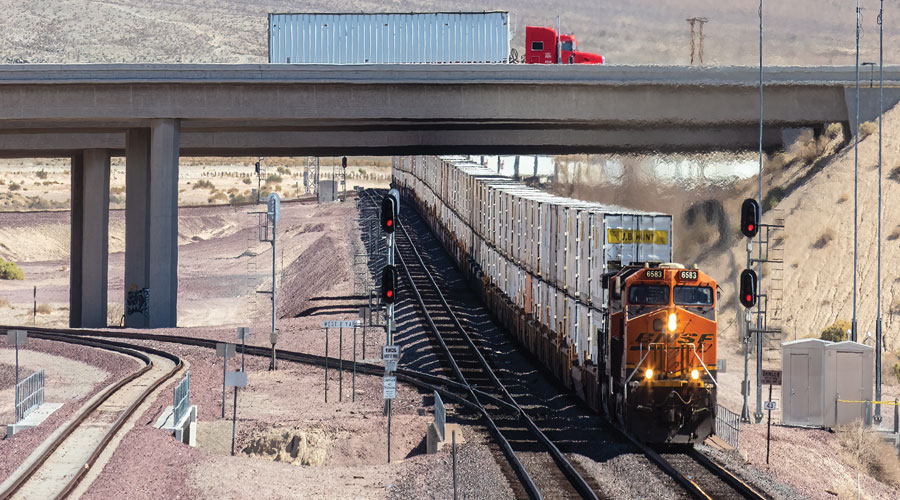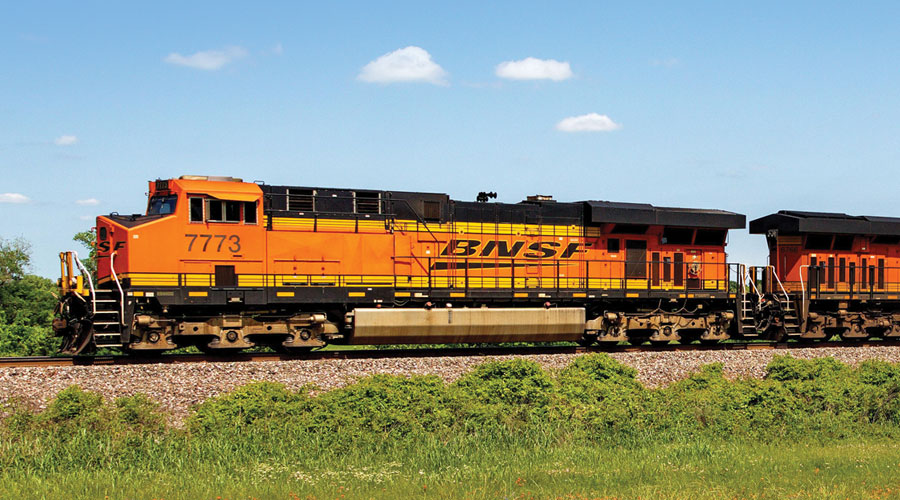Stay updated on news, articles and information for the rail industry
May 2012
Rail News: Rail Industry
The information technology evolution at BNSF
— by Pat Foran, Editor
Talking information technology (IT) is second nature to Jo-ann Olsovsky, and on an early mid-April morning, she's in her element. BNSF Railway Co.'s vice president of technology services and chief information officer has set up shop in the Heritage Conference Room in BNSF's technology services office building, which is less than half a mile from the Class I's headquarters in Fort Worth, Texas.
"I took the liberty of putting together a few slides," Olsovsky says.
Her PowerPoint, which features a BNSF technology overview, key technologies already adopted, a 2012 project list, and a focus on people and workforce issues, sums up BNSF's multi-layered, near-term IT strategy succinctly. It also serves as a case study of the evolution of a digital railway. From creating a "mobility vision" to nurturing a collaborative problem-solving approach to tapping into the consumerization of IT, Olsovsky and her team have a full plate this year. Just like they do every year. But with IT, timing's the thing. It's about staying a step ahead, technology and idea-generation wise, without always actually taking a step. For IT leaders, it's about being a visionary and a managed risk-taker, often at the same time.
For Olsovsky, it all adds up to leveraging technology to help make BNSF a better railroad.
"How can I improve the efficiency of the railroad? That's what Matt and Carl challenge me to do," Olsovsky says, referring to BNSF Chairman and Chief Executive Officer Matt Rose, and President and Chief Operating Officer Carl Ice. "What can I do to improve the business?"
Availability Is Key
It's an approach Olsovsky has taken since she joined the Class I in 2006 as assistant vice president of telecommunications. Prior to joining BNSF, she spent 10 years with GTE/Verizon Communications, and 13 years with AT&T. In 2008, Olsovsky was promoted to BNSF's top IT job. Since then, she's been responsible for delivering the railway's telecommunications services, data center infrastructure, system applications and all other IT services.
The technology services team supports more than 40,000 BNSF employees at more than 2,700 locations. The department comprises more than 1,000 employees, including 450 scheduled field employees. IBM Corp. provides data center infrastructure support. BNSF also enlists the services of InfoSys Technologies, an India-based consulting and software company.
BNSF's core IT infrastructure is massive. The railway hosts three data centers, four mainframes and 1,700 servers. The Class I has 6,000 miles of fiber and 14,000 miles of microwave. Eighty thousand communication radios provide 28,000 miles of radio coverage.
"I run a mini phone company," Olsovsky says. "We go to places phone companies don't go."
System availability, then, is paramount. As ever, the aim is "five nines," as in a system that is up and running 99.999 percent of the time, she says.
"First and foremost, we have to improve system availability," she says. "There's this joke: In IT, we can't make trains move faster, but we sure can slow them down."
Assorted network technology issues had a hand in said slowdowns in the early 2000s, Olsovsky says. But since 2006, the technology services department has posted a 72 percent reduction in "technology caused" train delays — from 13,417 minutes in 2006 to 3,805 minutes in 2011, she says.
In the meantime, technology continues to help departments railroad-wide improve business processes and drive efficiencies.
"In IT, our charge is to be forward thinkers — we have to be forward thinkers — and good stewards of the technology investments we deploy," Olsovsky says.
Being a good steward means getting out from behind the desk and into the real rail world, she believes.
"I've gone out in the field with track inspectors, I've sat in the [locomotive] cab, I've put on work boots. That's what makes the difference between an O.K. CIO and a great CIO," Olsovsky says. "You need to know how the railroad works, you need to see how users are using tools. I encourage my directors and managers to get out there, too."
It's part of what it means to stay the forward-thinking course.
"We need to help the business to be agile, so we have to find ways to understand what our cost drivers are," Olsovsky says. "We have to understand changing business needs, as well as all the changing IT needs and advances."
Mobility Matters
Given the pace at which IT has been advancing, getting a handle on that change has been no mean feat. From the host/mainframe era of the 1960s, to the client/server-driven 1980s and desktop and web realms in the 1990s, through the mobile and wireless world of the 2000s, new technology has come and gone at BNSF. It's also come and stayed, evolved and established paths to new technology directions.
Accordingly, Olsovsky's "Technologies in Use at BNSF" PowerPoint slide runs the gamut — from geographic information systems (GIS) to biometric time clocks to remote video inspection to positive train control (PTC) to voice recognition to the still-evolving world of wireless.
"It's just a sampling," she says of her list of 28 technologies. "There's always more to come."
Particularly given the exponential growth in computing power during the past several decades. Olsovsky cites Moore's Law, which loosely states that the number of transistors that can be placed inexpensively on an integrated circuit doubles every couple of years. For instance, an iPad 2 has as much computing power as a Cray 2 supercomputer, c. 1985.
"The way Moore's Law has evolved, we can now leverage it," she says.
One such leveraging exercise: Olsovsky and her team are in the process of creating a mobility vision.
"We need to be device agnostic," she says.
The IT team is rolling out the mobility strategy in phases. In March 2011, BNSF unveiled four mobile applications designed to enable customers to manage rail shipments on their smart phones. The applications — Unit Trace, Switch and Release, Coal Train Tracing and Display Lot Location — are available on BNSF's website. The apps can be accessed via BlackBerry, iPhone, Android or Windows 7 phones.
"I don't want anybody to think that doing business with the railroad is difficult," Olsovsky says. "I want it to be so easy to do business with us that they won't ever leave."
Customers are using the mobile apps. From June 2011 through February 2012, "track your shipment" usage via the apps was up 50 percent, Olsovsky says. Meanwhile, a recently established in-house mobility team plans to push the envelope even further. An acronym gaining traction at BNSF and within IT departments everywhere is "BYOD," as in "Bring Your Own Device." Olsovsky credits the long-simmering consumerization of IT, which is now at a full boil.
"We're a BlackBerry shop, but people want to be able to use what they use," she says. "You can't stop it."
And as the BYOD grip tightens, the need for collaboration on the problem-solving front will be that much greater.
"Increasingly, it's about work-life integration," Olsovsky says. "And to me, you can't do anything personally or professionally without leveraging technology to some degree."
The IT team plans to do a whole lot of leveraging in the applications arena this year. In addition to pursuing device-agnostic solutions, Olsovsky's team will focus on assessing cost, risk and utilization. What tools can be consolidated? Which need to be retired? When is the right time to upgrade? What should be developed in-house? Should it be developed in-house?
"One of my mantras is ‘Buy vs. Build,'" she says. "We really have to analyze it. You don't have to build everything yourself."
The Social Business Network
Other priorities include analytics development and system modernization. Regarding the latter: BNSF's transportation system — Transportation Support System — was developed in the late 1980s and "lives" on a mainframe, Olsovsky says. The next step? Making the system "GPS driven," she says. Also on the to-modernize list: revenue accounting and customer relationship management systems.
Social media applications, too, are on the project docket. The IT team is partnering with the corporate communications and human resources departments to determine how BNSF can conduct more "social business," as Olsovsky puts it. One initiative includes using salesforce.com's Chatter, a private social network. In another project, shippers can chat (via social network) with BNSF customer service reps rather than communicating via phone.
With respect to IT infrastructure, system availability and network security work remain points of emphasis. Keeping tabs on and, where necessary, investing in next-generation networks and user devices also is top of mind. Leveraging GIS and "hosted alternatives" (e.g., salesforce.com's Chatter) will be part of the mix, Olsovsky says.
"Again, we don't need to create everything from scratch," she says. "Total cost of ownership is something I want my people to think about."
In the meantime, work continues on systems, applications and products in data processing (SAP) related software projects, including the implementation of an enterprise asset management system. The SAP software supports finance, human resources and payroll applications. Two years ago, BNSF began implementing life-cycle management and learning management systems. Other infrastructure projects include next-generation voice and video, PTC, virtualization and tiered storage. Workforce systems, too, are on IT's radar.
"The railroad has to reduce the time it takes to hire people," Olsovsky says, noting looming railroad retirements and longer-term growth expectations.
A Story To Tell
Workforce issues also loom large in the IT department. Year in and year out, Olsovsky's top three challenges are safety ("We have people climbing 400-foot towers that we have to keep safe"), network security and system availability. But now, workforce development is right up there with the Big Three.
"We can't do all that we need to do if we don't have the talent," she says. "And I do have an aging workforce."
About 25 percent of her department's leaders are age 55 or older. In five years, nearly 40 percent of them will be 55-plus. So, Olsovsky is exploring organizational restructuring opportunities, as well as role divisions. In the meantime, she knows she's got recruiting, mentoring and knowledge sharing (and transferring) work to do. Increasingly, that work is putting her in front of various publics.
"I want to tell the story," Olsovsky says, citing both the BNSF and rail-as a-growth-industry stories. "We've got a great one here."
It helps that BNSF has talent — the kind that gets noticed, Olsovsky says. IT industry publications have bestowed numerous awards upon BNSF's IT team in recent years. Among them: Computerworld awarded BNSF a Best Practices in Business Intelligence award for "Best Data Visualization, Prediction and Presentation" in 2006. The publication also has recognized the Class I as one of the 100 Best Places to Work in IT three times during the past six years, and selected Olsovsky among its "Premier 100 IT Leaders" for 2010. She also was named one of Hispanic Engineer & Information Technology Magazine's Top 200 Most Influential Hispanics in Technology in 2011.
In the meantime, Olsovsky will continue working on a Railroading 2020 plan designed to keep the IT department, and BNSF, on track for the next decade. Not that she ever doubted the Class I would continue moving in the right direction.
"I have a vast appreciation for the people of BNSF," Olsovsky says. "It's the most unselfish, service-oriented organization I could ever hope to be around."
And in an IT-driven world, where collaboration and ease of doing business rule, that unselfishness will be invaluable.
"I'm really looking forward to helping shape what comes next," Olsovsky says.


 LRW Honors Amtrak’s Acheson As Railway Woman Of The Year
LRW Honors Amtrak’s Acheson As Railway Woman Of The Year
 From Editor-In-Chief Foran: Of Gender Equity And Inclusion
From Editor-In-Chief Foran: Of Gender Equity And Inclusion
 Spotlight On Some Of Today’s Rail Safety Products
Spotlight On Some Of Today’s Rail Safety Products
 Women of Influence in Rail eBook
Women of Influence in Rail eBook
 railPrime
railPrime







